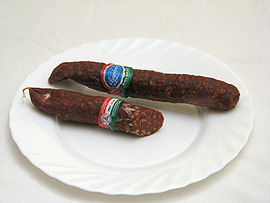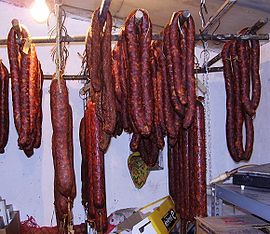
Kolbász
Encyclopedia

Cuisine of Hungary
Hungarian or Magyar cuisine is the cuisine characteristic of the nation of Hungary and its primary ethnic group, the Magyars. Traditional Hungarian dishes are primarily based on meats, seasonal vegetables, fruits, fresh bread, cheeses and honey...
produces a vast number of types of sausages. The most common smoked Hungarian sausages are Gyulai Kolbász, Csabai Kolbász, Csemege Kolbász, Házi Kolbász, Cserkész Kolbász, lightly smoked, like Debreceni Kolbász (or Debrecener
Debrecener
A debrecener is a pork sausage of uniform fine texture and reddish-orange colour, named after the Hungarian city of Debrecen. Also known as "Debreziners", the sausages are heavily spiced with paprika and other seasonings like garlic, pepper and marjoram. They are usually unsmoked or lightly...
) and Lecsókolbász, a spicy sausage made specifically for serving as part of the dish Lecsó
Lecsó
Lecsó is an originally Hungarian thick vegetable stew which features peppers and tomato, onion, lard, salt, sugar and ground paprika as a base recipe. In northern Hungary, the onions and peppers are usually sauteed in lard or bacon fat, while in the south sunflower oil is more commonly used...
, a vegetable stew with peppers and tomatoes. Hungarian
Hungary
Hungary , officially the Republic of Hungary , is a landlocked country in Central Europe. It is situated in the Carpathian Basin and is bordered by Slovakia to the north, Ukraine and Romania to the east, Serbia and Croatia to the south, Slovenia to the southwest and Austria to the west. The...
boiled sausages are called "Hurka", Liver Sausage, "Májas", and Blood Sausage
Blood sausage
Black pudding, blood pudding or blood sausage is a type of sausage made by cooking blood or dried blood with a filler until it is thick enough to congeal when cooled. The dish exists in various cultures from Asia to Europe...
, "Véres". The main ingredient is liver and rice, or blood and rice.Spices, pepper and salt are added.
Different regions in Hungary may have their own sausage recipes and tastes. The Hungarian sausages may be boiled, fresh or dried and smoked, with different spices and flavours, "hot" or "mild".
These sausages may be eaten like a cold cut or used in the main courses. The Hungarian Cuisine
Cuisine of Hungary
Hungarian or Magyar cuisine is the cuisine characteristic of the nation of Hungary and its primary ethnic group, the Magyars. Traditional Hungarian dishes are primarily based on meats, seasonal vegetables, fruits, fresh bread, cheeses and honey...
uses the different types of sausages in many ways, in vegetable stews, soups, potato stews like "Paprikás krumpli" (paprika-based stew with spicy sausage and potatoes), bean soups like Jókai bableves, in meat stews, in some goulash soup variations, pastry dishes and even salads.
The smoked sausages may contain bacon, ground pork, beef, boar or lamb, paprika
Paprika
Paprika is a spice made from the grinding of dried fruits of Capsicum annuum . In many European languages, the word paprika refers to bell peppers themselves. The seasoning is used in many cuisines to add color and flavor to dishes. Paprika can range from mild to hot...
, salt, garlic, black pepper
Black pepper
Black pepper is a flowering vine in the family Piperaceae, cultivated for its fruit, which is usually dried and used as a spice and seasoning. The fruit, known as a peppercorn when dried, is approximately in diameter, dark red when fully mature, and, like all drupes, contains a single seed...
, allspice, white pepper, caraway
Caraway
Caraway also known as meridian fennel, or Persian cumin is a biennial plant in the family Apiaceae, native to western Asia, Europe and Northern Africa....
, nutmeg
Nutmeg
The nutmeg tree is any of several species of trees in genus Myristica. The most important commercial species is Myristica fragrans, an evergreen tree indigenous to the Banda Islands in the Moluccas of Indonesia...
, zest, marjoram, cayenne pepper, sugar, white wine or cognac.
The meat is coarsely ground and salted. If garlic is added, it is mashed in water to produce a slurry and added to the meat along with spices. The sausage is then stuffed into natural casings in 1-foot links - usually using the small intestine of the pig. This traditionally took place outside on the fall day when a pig was slaughtered. The sausage is then hung overnight to allow the flavors to meld and some of the grease to drip out. It is now ready to be used fresh and unsmoked. Fresh sausages may have additional ingredients like liver, mushroom, bread, rice, lemon juice, eggs, cream or milk. The unsmoked sausages are typically roasted with sauerkraut or red or green cabbage, and served with mashed potatoes.
The dry sausages are cold smoked and hung to cure before use.
Sausages

"Csabai" - sausage. The Csabai kolbász is made in the town Békéscsaba
Békéscsaba
Békéscsaba is a city in Southeast Hungary, the capital of the county Békés.- Geography :According to the 2001 census, the city has a total area of .- Name :...
, and has PGI
Protected Geographical Status
Protected Geographical Status is a legal framework defined in European Union law to protect the names of regional foods. Protected Designation of Origin , Protected Geographical Indication and Traditional Speciality Guaranteed are distinct regimes of geographical indications within the framework...
protection. There are several variations in size and type, but it is a spicy sausage with a lot of paprika
Paprika
Paprika is a spice made from the grinding of dried fruits of Capsicum annuum . In many European languages, the word paprika refers to bell peppers themselves. The seasoning is used in many cuisines to add color and flavor to dishes. Paprika can range from mild to hot...
.
"Gyulai" - sausage is a different sausage, using different spices. It is named after the Hungarian town of Gyula
Gyula, Hungary
Gyula is a city in Békés county in south-eastern Hungary. It lies close to the border with Romania, on the river Fehér-Körös.-History:The first recorded reference to Gyula was in a document dated 1313 which mentions a monastery called Gyulamonostor . By 1332 the settlement around the monastery was...
. At the World Exhibition of Food in Brussel 1935, the Gyulai Kolbász (which also has PGI
Protected Geographical Status
Protected Geographical Status is a legal framework defined in European Union law to protect the names of regional foods. Protected Designation of Origin , Protected Geographical Indication and Traditional Speciality Guaranteed are distinct regimes of geographical indications within the framework...
protection) was awarded a gold diploma. The sausage may be cut into thin slices and eaten alone or with bread. They are also added to many Hungarian dishes including Lecsó
Lecsó
Lecsó is an originally Hungarian thick vegetable stew which features peppers and tomato, onion, lard, salt, sugar and ground paprika as a base recipe. In northern Hungary, the onions and peppers are usually sauteed in lard or bacon fat, while in the south sunflower oil is more commonly used...
and Potato/Egg Casserole (Rakott Krumpli).
"Debreceni Sausage
Debrecener
A debrecener is a pork sausage of uniform fine texture and reddish-orange colour, named after the Hungarian city of Debrecen. Also known as "Debreziners", the sausages are heavily spiced with paprika and other seasonings like garlic, pepper and marjoram. They are usually unsmoked or lightly...
" is usually unsmoked or more mildly smoked, with a strong paprika flavour and used for cooking.

